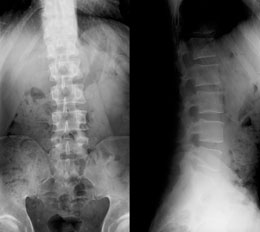Lordosis is an extreme inward curvature in the vertebral column. This article provides information regarding the causes, symptoms, and treatment of the same.

Lordosis, also known as swayback, is a very common condition that occurs in people irrespective of age. It is a spine disorder that is characterized by excessive curvature in the lower back area. Hollow back or saddle back are the terms used to describe excessive lordotic curvature.
A normal spine, though appears straight when viewed from behind, has four natural curves: cervical curvature, thoracic curvature, lumbar curvature, and sacral curvature. The cervical and lumbar curves are together known as lordotic curves, whereas the sacral and thoracic curves are known as kyphotic curves. These curves along with the inter-vertebral discs play an important role in absorbing and distributing mechanical stress that occurs from everyday activities. However, excessive inward curve may occur due to certain reasons, and this condition is known as lordosis.
Causes
Lordosis of the spine is generally caused because of the difference in thickness between inter-vertebral discs. Sometimes, some of the muscles around the hip region and the spine become tight while some become weak and stretched. This results in an imbalance, and the condition is known as lower-crossed syndrome, which can cause a curvature in the spine. There are several causes of this condition. They are:
- Osteoporosis
- Achondroplasia
- Obesity
- Spondylolisthesis
- Posture
- Kyphosis
- Tight low back muscles
- Pregnancy
- Excessive visceral fat
Symptoms
Excessive lordotic curvature may result in excessive strain on the lower back. The affected person may have a poor vertebral posture. The buttocks protrude outward more than usual and the lower back dips inward, resulting in an exaggerated posture. The indications may vary from person to person, and some may suffer from pain in the lower back and down the legs, and changes in the bowel and bladder habits. Sometimes, the symptoms may resemble other spine deformities. Hence, it is advisable to consult a physician for proper diagnosis.
Treatment
The condition generally does not cause any discomfort or serious problems and often does not require any special treatment. However, if the condition is severe, the curvature may lead to severe pain in the lower back and needs to be treated. Diagnostic procedures for swayback include X-rays, magnetic resonance imaging, bone scans, computed tomography scan, and blood tests.
The treatment depends on the nature and severity of the lordotic curvature. The non-surgical conservative treatments may include pain management drugs, like analgesics or anti-inflammatory medications, physical therapy including some specific exercise programs, back bracing, and reduction of excess body weight. Exercises include stretching of the overactive muscles like the hip flexors and strengthening the abs and hip extensors. One could perform stiff leg deadlifts, low bar squats, or glute hamstring raises. The progression of the skeletal curve is checked frequently during the course of treatment in order to prevent the deformity.
Severe lordosis, however, may cause serious health problems, and hence, may require surgery. A spine surgery may be required when all the non-surgical treatments fail to provide relief. There can be different surgical procedures involved depending on the type and intensity of the curvature. Spinal fusion is a type of corrective surgery which is often recommended in case of extreme swayback. A specific diet and a daily exercise plan may be prescribed after the surgery for effective recovery.
Early detection of the condition can give you several treatment options and ensure effective recovery. However, if you have lordosis, but do not suffer from any serious symptoms, there is no need for any treatment.
Disclaimer:
This Buzzle article is for informative purposes only, and should not be used as a replacement for expert medical advice.


 Lordosis, also known as swayback, is a very common condition that occurs in people irrespective of age. It is a spine disorder that is characterized by excessive curvature in the lower back area. Hollow back or saddle back are the terms used to describe excessive lordotic curvature.
Lordosis, also known as swayback, is a very common condition that occurs in people irrespective of age. It is a spine disorder that is characterized by excessive curvature in the lower back area. Hollow back or saddle back are the terms used to describe excessive lordotic curvature.